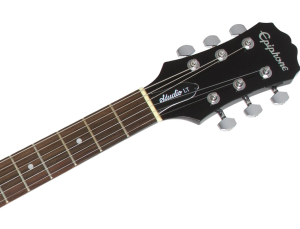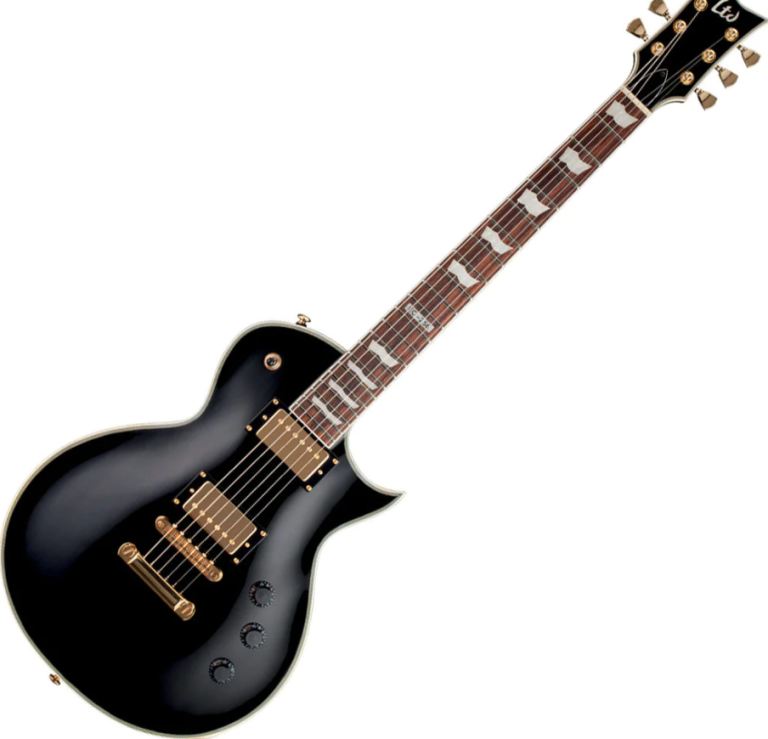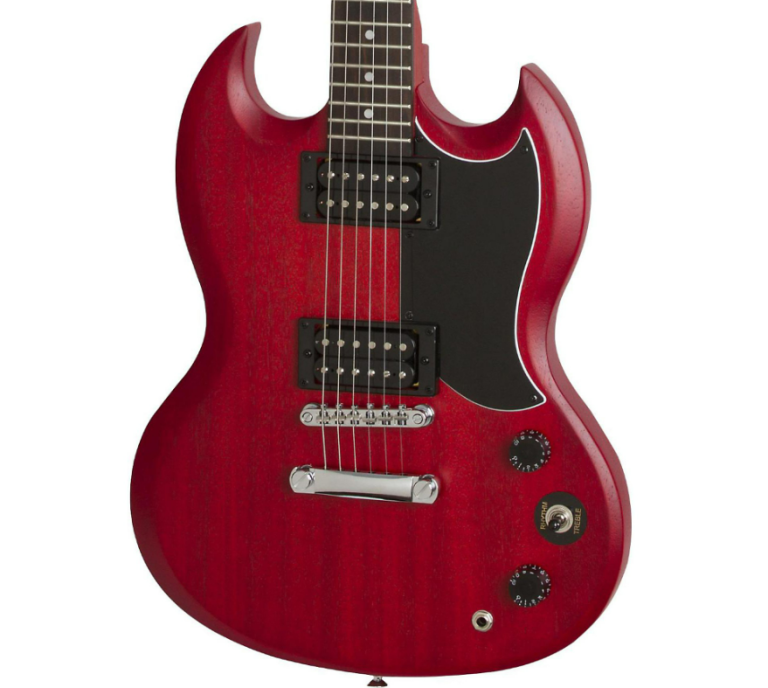Epiphone Les Paul Studio LT Review
Guitar players know that when getting gear and accessories, the price you pay directly dictates the level of quality you are getting from your purchase. There are a ton of entry-level guitars in the market and most of them are pretty good for players just starting out.
However, lots of these tend to have intonation issues and little flaws that can really be annoying once you’re past a certain skill level. If you prefer to go the traditional route and decide to get a Squier, you will soon find that the pickups need upgrading.
If you started on single-coil pickups, you will want to upgrade to noiseless ones or humbuckers. That’s just the way it works for most of us!
What if you wanted a good one right off the bat and didn’t want to upgrade your playing setup too soon? As far as full-size Les Pauls are concerned, the Epiphone Les Paul Studio LT electric guitar is one of the ideal guitars for beginners!
While it’s geared toward players who are looking to get into metal, it’s got lots of features to add value to any musical genre you decide to play. I find that it’s a great instrument for somebody on a budget who wants a quality instrument with good parts.
Is the Epiphone Les Paul Studio LT really an ideal guitar for the average guitarist (or a complete beginner)? Let’s find out!
Does Epiphone Make Good Guitars?
Before we get into the actual details of the Les Paul Studio LT, it’s a good idea to look at the company’s endeavors.
When I hear the Epiphone name, I think about affordable guitar models that I can afford. The brand has gained a lot of trust, and I can say confidently that if I walked into one of their stores and got a guitar, I would be a happy man afterward.

Epiphone was originally founded in 1873 in present-day Turkey by a Greek luthier Stathopoulus who sold hand-made lutes and fiddles.
After relocating to the States in 1903, the son of the founder- Epaminondas decided to name Epiphone after his nickname ‘Epi’, and ‘phone’ which is Greek for voice.
The brand was known for the quality mandolins and banjos it sold. You probably didn’t know that the brand was also named the Epiphone Banjo Company in 1928, the same year it started producing guitars.
When Epi passed away, his brothers got the rights to Epiphone, and putting it short, they did manage it well. By the early sixties, Epiphone was a leading manufacturer of archtop guitars, and Gibson bought Epiphone in 1957.
Since then, the brand has been used to produce budget copies of Gibson’s overpriced guitars as well as to make signature models for bands like The Beatles.
It is very easy to see why some players might consider Epiphone guitars second-rate but I find that these offer excellent value for the price. I have never had any issues with an Epiphone, so I’ve got nothing to complain about.
Review of Epiphone Les Paul Studio LT
Too lazy to read the full review? Here’s a quick summary!

What We Think
The Epiphone Les Paul Studio LT is a fantastic beginner guitar with quality hardware and electronics.
It’s just a quarter of the price of the cheapest Gibson and has two beautiful and fantastic-sounding humbucker pickups that lend well to a variety of playing styles. Whether you’re just starting to learn rock riffs with pentatonic scales or a gigging pro, it’s got something for everybody.
You will probably want to swap the strings out for something like the D’Addario or Ernie Ball Slinky strings but other than that, you can rock with this straight out of the case.
Features
- All-mahogany neck and body
- Tune-O-Matic bridge
- Beautiful rosewood frets on a budget guitar
- Medium jumbo frets
- Beautiful finishes
Aesthetics
I am a huge fan of guitars without finishes and pickguards. I prefer to have a natural grain of wood on my guitars, and overall, I just like having the look of wood. The Les Paul Studio LT does not have a pickguard so you might scratch the body with your picking hand but it does look super nice.
One of the things that the Les Paul Studio LT does differently from the Gibson Les Paul is that it features dot inlays. This choice does not sit nicely with most players as they are used to seeing trapezoid inlays. It is a non-issue really, as you can easily change them with something you like – I would suggest checking out Abalone inlays.
I like trapezoid inlays too, and part of the reason why I love Ibanez and Schecter Omen guitars so much is that they’ve got cool inlays.
The Epiphone slim taper neck feels super nice in your hands as it has got a D-shape neck profile. The headstock has a silver Epiphone insignia which adds a touch of elegance to the instrument.
The guitar is available in many finishes, and you should choose one that you really like.
Tuning
You may be well aware of the fact that the tuners on an electric guitar, or any stringed instrument, for that matter- can make or completely break the intonation. The Epiphone Studio LT does not offer best-of-the-line tuners but does provide a fairly average tuning mechanism that won’t go out of tune very frequently.
The tuners are standard chrome diecast tuning machines that aren’t too rigid.
Some players also upgrade to locking tuners or Floyd rose to ensure that they aren’t out of that tune. Me, I find that having to tune my guitar every time I pick it up has become a habit, and as annoying as it may be, it’s a good habit. I think having a decent tuner like the Snark SN5X pays off more in the long run than worrying about locking tuners!
What I don’t like about the guitar is that it’s got a crappy nut. If I were getting this guitar, I would happily purchase a bone nut and do the replacement the next day I got the guitar.
It does not do much for the aesthetics but does enhance the tuning stability.
So, while the tuners may not be suited for something that involves lots of bends and whammy bar action, it’s certainly good enough for most guitar players out there.
Neck

If you look at the neck, the Epiphone Les Paul Studio LT electric guitar has got a surprise up its sleeve! The guitar has a bolt-on mahogany neck with rosewood frets which looks very beautiful.
If you are new to the tonewood used on guitars, manufacturers don’t usually use rosewood on budget guitars. That’s because it is quite expensive and raises production costs. Companies also tend to use cheaper woods instead of Mahogany, so having that here is certainly nice.
There is a tapered heel joint at the place the mahogany neck meets the mahogany body.
Some suppliers may also be selling cheaper Poplar necks, so that’s something you should look out for.
I am not a fan of bolt-on neck construction and prefer glued necks but I don’t think it is that big an issue. Both neck types hold up quite well, and bolt-on necks are easier to replace if you break a guitar neck by accident.
Some players swear by set necks saying that they have an enhanced resonance but, personally, I have yet to hear any difference in tonal characteristics.
There are 22 medium jumbo frets which is a pretty standard size on most guitars. Even if you have large hands or unusually small fingers, you won’t have much difficulty learning on the frets.
The neck looks absolutely gorgeous thanks to the rosewood fingerboard. It’s one of the things that I like the most about this guitar.
If there’s one thing amiss about the Epiphone Les Paul Studio LT, it’s got to be the intonation on some frets. You won’t notice the frets going out of tune most of the time, but if you tend to play lead lines a lot, you may want to take this guitar for quick fret leveling.
Over time, I’ve learned to do most of the tweaking on my own, and would highly recommend you take the time to learn how to set up your guitar neck yourself. If you are not too comfortable doing that, you can always have a luthier do it for you.
When you hold the guitar in your hands, the first thing you will notice is how slim and nice the neck feels. It has a D-shape profile that is very comfortable to fret.
As always, the Epiphone guitar has a truss rod that you can easily adjust if you find that the string height is not what you would like it to be. You just need an Allen key and you turn the truss rod clockwise or anticlockwise to your liking. I prefer the Ibanez multi-tool for this and recommend the same.
If you’ve ever been to a guitar shop to ask for adjusting the action, you may have noticed that all they do is turn the truss rod a bit and maybe wipe the neck with a fancy cloth. And they charge you a bit for that.
You may prefer leaving it to somebody more experienced but I like taking care of simple stuff like that on my own. It’s no different from tuning, really, and if you love to play music, you will be running into such encounters quite a bit. Learning to adjust the action will also save you time and money later on.
Back to the Epiphone Studio LT, the slim neck design is also where Epiphone departs from the thick necks found on Gibsons, and that’s definitely a great stylistic decision!
Body
The solid body on the Les Paul Studio LT is made out of mahogany wood which is an excellent choice for the body material. Inspired by the aesthetic of premium guitars, the Les Paul Studio LT features a sleek and elegant body.

Guitars in the mid-price range tend to substitute the guitar body material with cheaper woods like Alder or some Chinese-grown wood without much care for the tonal characteristics. I find that most woods do sound the same on an electric guitar.
What’s more important, in my opinion, is that regardless of the wood material, the guitar has to feel nice and smooth when you are playing it. The solid, all-mahogany construction feels very durable as well.
The all-mahogany body is quite rigid and has a Tune-O-Matic bridge combo that helps with the intonation. If you want spot-on intonation, you can also go for the locking Floyd Rose mechanism. These can be an absolute pain in the ass but do help with the tuning stability.
Pickups And Controls On Les Paul Studio LT
One thing that I really like about the Epiphone Les Paul Studio LT electric guitar is that it has got premium humbucker pickups that sound super cool. If there is one thing that a beginner needs, it’s not some fancy-looking pickguard or a cool finish but nice-sounding pickups.
Single coil pickups, which are the standard choice on most entry-level guitars, while good enough for most beginners to start on- produce a lot of noise and interference. To me, they are very annoying to listen to, and I would much rather spend a bit more to get noiseless pickups.
The pickups have got a lot to live up to- considering that they have to live up to the name of famed guitar models as well.
Having humbuckers is also good for versatile playing, as the rich fat tone lends itself nicely to anything from classic rock to heavy metal. Humbucking pickups are also especially good for fingerstyle arrangements on electric guitars.
The distinctive feature of these zebra coil pickups is that they have beautiful dark and white streaks that look quite elegant. The dual zebra humbuckers sound fat and lush, and I couldn’t ask for better-sounding ceramic humbuckers on a budget guitar.
Speaking of controls, you can select the pickup output with the help of a 3-way selector switch that lets you switch between the neck, mid, and bridge positions.
Neck pickup configuration
The neck pickup is manufactured specifically so it has a less shrill sound when you play beyond the 12th fret. So, the warm tone is good for playing solos, and that’s exactly what most players do.
Mid pickup configuration
The mid position has an intermediate sound and is good if you don’t want to lose the top end while having a bright sound. Most beginner guitar players think of this position as a default for playing fingerstyle.
This is also a favorite of metal guitarists as it has a distinct sound to it.
Bridge pickup configuration
The bridge pickup offers a brighter and snappier sound that sounds great in the rock or metal context. Just play around with the EQ controls on your amp, and you will get a rich punchier tone.
Some players think that you don’t mess around with the 3-way switch, and you select a tone before you play. I find that too limiting, and as switching between pickups mid-way also helps with variety in different parts of the song, I recommend playing around to see what you like.
To the right, you can find two volume knobs for controlling the volume output and two-tone controls that let you shape the tone.
The separate controls feature is very helpful so that you don’t mess up one configuration while adjusting another.
Sound of the Epiphone Les Paul Studio LT
The Les Paul Studio by Epiphone is versatile for both clean tones and heavy overdriven sounds. The top end is where the guitar shines, and the sound is kind of comparable to that of a Gibson.
Remember when I said this had independent controls for each pickup? The cool thing about that is that you can let a bit of the sound from neck pickups bleed into the bridge pickup sounds.
The Les Paul Studio LT sounds pretty good as it has got dual humbucker pickups. I personally prefer the warmer-sounding neck humbucker pickup good to use for rock as well as metal voicings. These do not have the noise that a single coil would cause, so that’s good too.
If there’s one thing that shines here, it’s the mid-range tone though you can also hear the bass boosted in the neck pickup configuration. It’s versatile and you can use the guitar for almost all genres including high-gain metal.
It’s less the guitar itself and more the amp and settings when it comes to a stage-ready sound. If you hook this guitar to a Marshall tube amp, you would be absolutely surprised by how neat it sounds!
This trick is also fairly common for reviewers that are showing reviews of cheap guitars. They tend to hook up the guitars to their expensive cabinet setups and that’s why, when you actually buy the cheap guitars, they sound nothing like the reviewer’s.
Some players just don’t like cheap guitars, and I understand where they are coming from. But I think the Les Paul Studio LT has a lot to offer at an affordable price and you should at least give it a chance. It’s a good choice as far as beginner-quality guitars are concerned, and you should stick to a budget amp like the Fender Champion 20, at least when you’re just starting out.
The Good
- Excellent beginner guitar
- Fantastic humbucker sound
- Can use for practice
The Bad
- Not for metal
- Needs fretwork
- Cheap tuners
Final Thoughts
The Les Paul Studio LT does have some harsh reviews that say that it has cheap tuners and cheap pickups, but I would say that it doesn’t cost much and isn’t a bad guitar either. Anything that a beginner can lay their hands on and practice on is probably a good guitar.
My opinion? Save up and get a better guitar.
If you absolutely want a beautiful guitar and are willing to upgrade later, or aren’t sure if guitar-playing is for you, the Les Paul Studio LT will be a great purchase for you. You will have to do the neck adjustments and string swaps, which, to be honest, you would have to do on just about any guitar in the price range of the cheapest guitars with decent playability.
Still, if you would like to look for an alternative, I would suggest looking at the Fender Squier Affinity Stratocaster. And check out our nice post on the best guitar accessories, we’ve listed lots of free things that will improve your playing as well!
FAQ
Who is the Les Paul Studio LT for?
The Studio LT features excellent playability and quality hardware that make up a killer instrument. It’s a solid purchase for any beginner or intermediate-level player who wants to get their feet into the world of electric guitars.
It’s also a good guitar for learning to wire and mod as it’s very cheap. You can also upgrade the pickups on this to something that you like.
Is the Epiphone Les Paul Studio LT a good guitar?
For the price, Studio LT is an excellent purchase. You may still want to look into the specifications to see if it’s what you want though.




